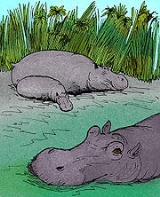
Hippopotamus gorgops
Encyclopedia
Hippopotamus gorgops is an extinct species
of hippopotamus
. It first appeared in Africa during the late Miocene
, and eventually migrated into Europe during the early Pliocene
(where its fossils were first discovered). It became extinct prior to the Ice Age
.
With a length of 4.3 metres (14.1 ft) and a shoulder height of 2.1 metres (6.9 ft) H. gorgops was much larger than its living relative, H. amphibius. Another feature setting it apart from H. amphibius were its eyes. Modern hippos have eyes placed high on the skull
, but H. gorgops took things a step further and had what could be described as short eye stalks, making it even easier for the creature to see its surroundings while (almost) fully under water.
Extinct species
This page features extinct species, organisms that have become extinct.* List of extinct animals* List of extinct plants...
of hippopotamus
Hippopotamus
The hippopotamus , or hippo, from the ancient Greek for "river horse" , is a large, mostly herbivorous mammal in sub-Saharan Africa, and one of only two extant species in the family Hippopotamidae After the elephant and rhinoceros, the hippopotamus is the third largest land mammal and the heaviest...
. It first appeared in Africa during the late Miocene
Miocene
The Miocene is a geological epoch of the Neogene Period and extends from about . The Miocene was named by Sir Charles Lyell. Its name comes from the Greek words and and means "less recent" because it has 18% fewer modern sea invertebrates than the Pliocene. The Miocene follows the Oligocene...
, and eventually migrated into Europe during the early Pliocene
Pliocene
The Pliocene Epoch is the period in the geologic timescale that extends from 5.332 million to 2.588 million years before present. It is the second and youngest epoch of the Neogene Period in the Cenozoic Era. The Pliocene follows the Miocene Epoch and is followed by the Pleistocene Epoch...
(where its fossils were first discovered). It became extinct prior to the Ice Age
Ice age
An ice age or, more precisely, glacial age, is a generic geological period of long-term reduction in the temperature of the Earth's surface and atmosphere, resulting in the presence or expansion of continental ice sheets, polar ice sheets and alpine glaciers...
.
With a length of 4.3 metres (14.1 ft) and a shoulder height of 2.1 metres (6.9 ft) H. gorgops was much larger than its living relative, H. amphibius. Another feature setting it apart from H. amphibius were its eyes. Modern hippos have eyes placed high on the skull
Skull
The skull is a bony structure in the head of many animals that supports the structures of the face and forms a cavity for the brain.The skull is composed of two parts: the cranium and the mandible. A skull without a mandible is only a cranium. Animals that have skulls are called craniates...
, but H. gorgops took things a step further and had what could be described as short eye stalks, making it even easier for the creature to see its surroundings while (almost) fully under water.

